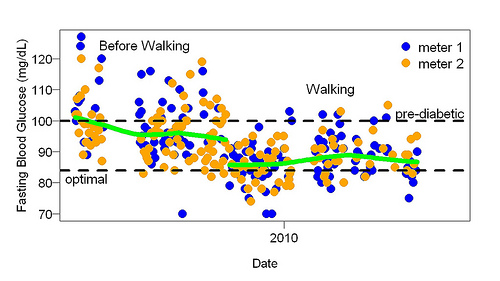Richard Bernstein, an engineer with diabetes, invented home blood glucose monitoring. To learn more about this invention, about two years ago I started doing it myself. Mostly I measured my fasting blood sugar level — the level you measure in the morning before eating anything. My numbers were okay — averaging about 90 mg/dL. Optimal is 84, readings above 100 are considered pre-diabetic. I stopped for a while. Then I resumed, and was shocked to see that the numbers were considerably worse — the average was in the high 90s.
I tried to lower them. The obvious thing to do was to eat less carbs, but I already ate few carbs. I cut my carb intake still further but the problem didn’t go away. The graph below shows a solution I found by accident: to walk 30-60 minutes/day (closer to 60 than 30).

After months of trying this and that, and nothing working, one morning the reading was good. I realized I’d done something unusual the previous evening: Taken a 30-minute walk home in the evening rather than ride my bike. After that I deliberately walked 50-60 minutes almost every day and found that my readings were much better, as the graph shows. It wasn’t always walking steadily for 60 minutes — stopping now & then was okay. However, wandering through stores for 60 minutes (or any length of time) didn’t seem to work. My walks were in the afternoon or evening.
I have not read elsewhere that non-diabetics should do this sort of monitoring, but it helped me. I have seen “exercise” recommended as a way to improve blood sugar control but what I found is much more specific. This article recommends walking about 3 miles/day, which is what I did. This research found big effects of substantial aerobic exercise. My walking was just ordinary continuous walking. But the details of my exercise aren’t the point: The point is you can find out for yourself what works.
This sort of thing looks even better when you learn that GlaxoSmithKline, the giant drug company, hid evidence that its diabetes drug caused heart attacks. The drug has generated billions in revenue for the company.
Sort of off topic. I am reading “Becoming a Successful Scientist” by Craig Loehle and he recommends long walks as an effective technique for deeper rumination and contemplation. Walking may be a toofer!
Jim